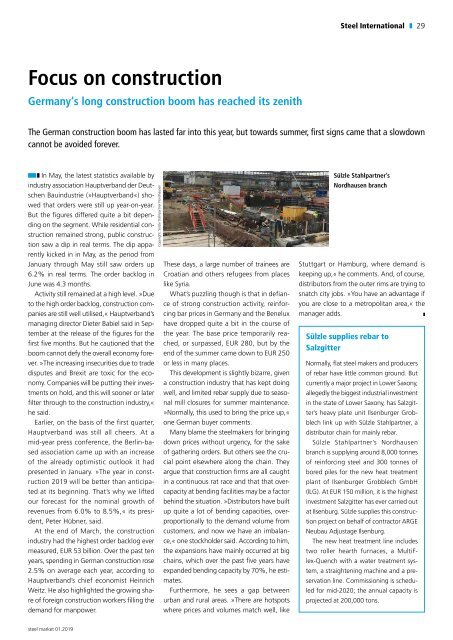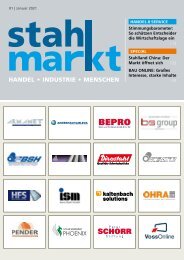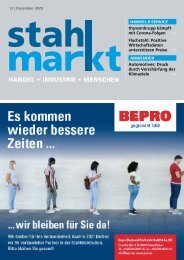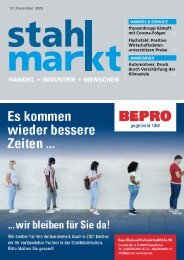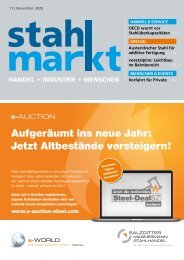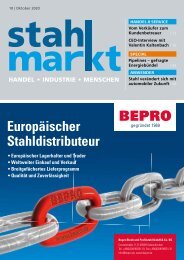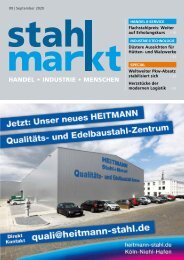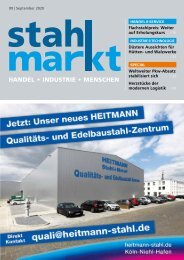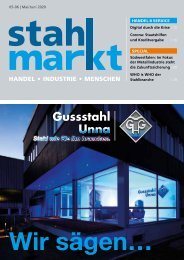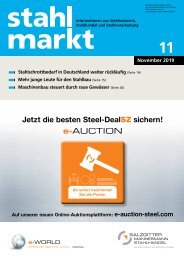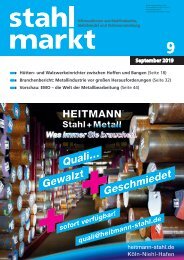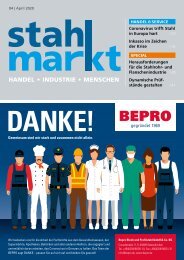stahlmarkt 09 | 2019
TOP -Themen: Hütten- und Walzwerkeinrichter zwischen Hoffen und Bangen (Seite 18) Branchenbericht: Metallindustrie vor großen Herausforderungen (Seite 32) Vorschau: EMO – die Welt der Metallbearbeitung (Seite 44) SPECIAL STAHLHANDEL & STAHL-SERVICE-CENTER EUROFER: Einbruch der Stahlnachfrage aufgrund schwacher Produktion - 30 Commerzbank-Bericht: Metallindustrie steht vor großen Herausforderungen - 32 XOM Materials fasst Fuß auf dem US-amerikanischen Markt - 35 LOGISTIK & HANDHABUNG, LAGERTECHNIK Aktionsplan »Niedrigwasser Rhein« vorgelegt - 38 Liebherr-Components Kirchdorf setzt auf Modernisierung und Erweiterung - 40
TOP -Themen:
Hütten- und Walzwerkeinrichter zwischen Hoffen und Bangen (Seite 18)
Branchenbericht: Metallindustrie vor großen Herausforderungen (Seite 32)
Vorschau: EMO – die Welt der Metallbearbeitung (Seite 44)
SPECIAL
STAHLHANDEL & STAHL-SERVICE-CENTER
EUROFER: Einbruch der Stahlnachfrage aufgrund schwacher Produktion - 30
Commerzbank-Bericht: Metallindustrie steht vor großen Herausforderungen - 32
XOM Materials fasst Fuß auf dem US-amerikanischen Markt - 35
LOGISTIK & HANDHABUNG, LAGERTECHNIK
Aktionsplan »Niedrigwasser Rhein« vorgelegt - 38
Liebherr-Components Kirchdorf setzt auf Modernisierung und Erweiterung - 40
Sie wollen auch ein ePaper? Erhöhen Sie die Reichweite Ihrer Titel.
YUMPU macht aus Druck-PDFs automatisch weboptimierte ePaper, die Google liebt.
Steel International 29<br />
Focus on construction<br />
Germany‘s long construction boom has reached its zenith<br />
The German construction boom has lasted far into this year, but towards summer, first signs came that a slowdown<br />
cannot be avoided forever.<br />
In May, the latest statistics available by<br />
industry association Hauptverband der Deutschen<br />
Bauindustrie (»Hauptverband«) showed<br />
that orders were still up year-on-year.<br />
But the figures differed quite a bit depending<br />
on the segment. While residential construction<br />
remained strong, public construction<br />
saw a dip in real terms. The dip apparently<br />
kicked in in May, as the period from<br />
January through May still saw orders up<br />
6.2% in real terms. The order backlog in<br />
June was 4.3 months.<br />
Activity still remained at a high level. »Due<br />
to the high order backlog, construction companies<br />
are still well utilised,« Hauptverband’s<br />
managing director Dieter Babiel said in September<br />
at the release of the figures for the<br />
first five months. But he cautioned that the<br />
boom cannot defy the overall economy forever.<br />
»The increasing insecurities due to trade<br />
disputes and Brexit are toxic for the economy.<br />
Companies will be putting their investments<br />
on hold, and this will sooner or later<br />
filter through to the construction industry,«<br />
he said.<br />
Earlier, on the basis of the first quarter,<br />
Hauptverband was still all cheers. At a<br />
mid-year press conference, the Berlin-based<br />
association came up with an increase<br />
of the already optimistic outlook it had<br />
presented in January. »The year in construction<br />
<strong>2019</strong> will be better than anticipated<br />
at its beginning. That’s why we lifted<br />
our forecast for the nominal growth of<br />
revenues from 6.0% to 8.5%,« its president,<br />
Peter Hübner, said.<br />
At the end of March, the construction<br />
industry had the highest order backlog ever<br />
measured, EUR 53 billion. Over the past ten<br />
years, spending in German construction rose<br />
2.5% on average each year, according to<br />
Hauptverband’s chief economist Heinrich<br />
Weitz. He also highlighted the growing share<br />
of foreign construction workers filling the<br />
demand for manpower.<br />
Copyright: Sülzle Stahlpartner Nordhausen<br />
These days, a large number of trainees are<br />
Croatian and others refugees from places<br />
like Syria.<br />
What’s puzzling though is that in defiance<br />
of strong construction activity, reinforcing<br />
bar prices in Germany and the Benelux<br />
have dropped quite a bit in the course of<br />
the year. The base price temporarily reached,<br />
or surpassed, EUR 280, but by the<br />
end of the summer came down to EUR 250<br />
or less in many places.<br />
This development is slightly bizarre, given<br />
a construction industry that has kept doing<br />
well, and limited rebar supply due to seasonal<br />
mill closures for summer maintenance.<br />
»Normally, this used to bring the price up,«<br />
one German buyer comments.<br />
Many blame the steelmakers for bringing<br />
down prices without urgency, for the sake<br />
of gathering orders. But others see the crucial<br />
point elsewhere along the chain. They<br />
argue that construction firms are all caught<br />
in a continuous rat race and that that overcapacity<br />
at bending facilities may be a factor<br />
behind the situation. »Distributors have built<br />
up quite a lot of bending capacities, overproportionally<br />
to the demand volume from<br />
customers, and now we have an imbalance,«<br />
one stockholder said. According to him,<br />
the expansions have mainly occurred at big<br />
chains, which over the past five years have<br />
expanded bending capacity by 70%, he estimates.<br />
Furthermore, he sees a gap between<br />
urban and rural areas. »There are hotspots<br />
where prices and volumes match well, like<br />
Sülzle Stahlpartner’s<br />
Nordhausen branch<br />
Stuttgart or Hamburg, where demand is<br />
keeping up,« he comments. And, of course,<br />
distributors from the outer rims are trying to<br />
snatch city jobs. »You have an advantage if<br />
you are close to a metropolitan area,« the<br />
manager adds.<br />
Sülzle supplies rebar to<br />
Salzgitter<br />
Normally, flat steel makers and producers<br />
of rebar have little common ground. But<br />
currently a major project in Lower Saxony,<br />
allegedly the biggest industrial investment<br />
in the state of Lower Saxony, has Salzgitter’s<br />
heavy plate unit Ilsenburger Grobblech<br />
link up with Sülzle Stahlpartner, a<br />
distributor chain for mainly rebar.<br />
Sülzle Stahlpartner’s Nordhausen<br />
branch is supplying around 8,000 tonnes<br />
of reinforcing steel and 300 tonnes of<br />
bored piles for the new heat treatment<br />
plant of Ilsenburger Grobblech GmbH<br />
(ILG). At EUR 150 million, it is the highest<br />
investment Salzgitter has ever carried out<br />
at Ilsenburg. Sülzle supplies this construction<br />
project on behalf of contractor ARGE<br />
Neubau Adjustage Ilsenburg.<br />
The new heat treatment line includes<br />
two roller hearth furnaces, a MultiFlex-Quench<br />
with a water treatment system,<br />
a straightening machine and a preservation<br />
line. Commissioning is scheduled<br />
for mid-2020; the annual capacity is<br />
projected at 200,000 tons.<br />
steel market 01.<strong>2019</strong>


